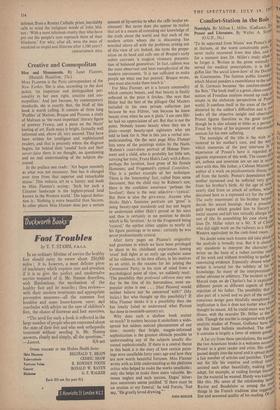Creative and Cosmopolitan
Men and Monuments. By Janet Flanner. (Hamish Hamilton, 25s.)
Miss FLANNER is the Paris correspondent of the New Yorker. She is also, according to the dust jacket, 'an important and distinguished per- sonality in her own right, creative and cos- mopolitan.' And just because, by contemporary standards, she is exactly that, the bluff of this book is worth calling. It consists of three long `Profiles' of Matisse, Braque and Picasso, a study of Malraux as 'the most important' literary figure of postwar France, and a piece on the Nazis' looting of art. Each essay is bright, factually well informed and, above all, very assured. They have been written for intelligent and sophisticated readers, and that is precisely where the disgrace begins, for behind their 'candid' facts and their savoir-faire there is no thought, no questioning and no real understanding of the subjects dis- cussed.
In the preface one reads : 'Art began remotely as what was not necessary. Nor has it changed over time from that superior and remarkable status.' This reduces art to a luxury and leads to Miss Flanner's saying : `Inch for inch a Cezanne landscape is the highest-priced land known in the Western world.' The logical deduc- tion is : Nothing is more beautiful than Success. In other places Miss Flanner does pay a certain
amount of lip-service to what she calls 'ocular ex- citement.' But never does she appear to realise that art is a means of extending our knowledge of the truth about the world and that each of the modern artists whom she is discussing has wrestled above all with the problems arising out of this view of art. Indeed, she turns the propo- sition on its head and calls one of Braque's early cubist canvases 'a magical visionary presenta- tion of balanced geometrics.' In fact, cubism was the most observant and least metaphysical of the modern movements. `It is not sufficient to make people see what one has painted,' Braque wrote, `one must also make them touch it.'
For Miss Flanner, art is a luxury commodity which contains beauty, and that beauty is finally reflected in the price it fetches. She says that Hitler had the best of the pillaged Old Masters included in his own private collection just because he was Ffihrer, 'not because he knew beauty even when he saw it plain.' I am sure Hit- ler had no appreciation of art. But that is not the point. Nobody knows beauty when they see it plain—except beauty-spot sightseers who are told to look for it. Nor is this just a verbal mis- understanding. On the next page Miss Flanner lists some of the paintings stolen by the Nazis. `Rubenis's court-dress portrait of Helene Four- ment and a child, who is probably her little son, carrying her train; Franz Hals's Lady with a Rose, perhaps the loveliest, least gross of his female likenesses; and Fragonard's cynical Comedien.' This is a perfect example of her technique. There is the 'interesting' fact, culled from some document, that the child may be Rubens's son; there is the confident assurance 'perhaps the loveliest'; there is the neat adjective—`cynical.' But there is also the give-away. Anyone who thinks Hals's feminine portraits are 'gross' is using beauty-spot standards and has not begun to understand either Hals's period or his aims and thus is certainly in no position to decide which is His loveliest.' As to the Fragonard being `cynical,' the epithet either applies to nearly all his figure paintings or to none : certainly he was never predominantly cynical.
After forty pages on Picasso's originality and greatness in which we have been privileged to share in his childhood experiences (seeing `cruel' bull fights at an early age explains some of his violence), in his love affairs, in his motives as an artist, in the reasons for his joining the Communist Party, in his state of mind from a psychological point of view, we suddenly read : `The possibility that profound oblivion may one day be the fate of his horrendous, most un- popular styles is one . . . [that Picasso] would neither believe nor be concerned with!' (My italics.) But who thought up this possibility? If Miss Flanner thinks it is a possibility then she has totally failed to understand what Picasso has done to twentieth-century art.
Why does such a shallow book matter so much? It matters because it underlines a wide- spread but seldom noticed phenomenon of our time : namely that bright, magpie-informed sophistication is the greatest obstacle possible to understanding any of the subjects usually dis- cussed sophisticatedly. If there is a central theme in this book it is the story of how certain paint- ings were unsellable forty years ago and how they are now worth beautiful fortunes. Miss Flanner writes with as little understanding as the philistine critics who helped to make the works unsellable: only she helps to make them more valuable. Be- tween neglect and such success, Degas' bitter- ness sometimes seems justified. 'If there must be an oration at my funeral,' he told Forain, `Just say, "He greatly loved drawing."'
JOHN BERGER














































 Previous page
Previous page